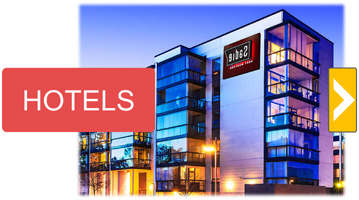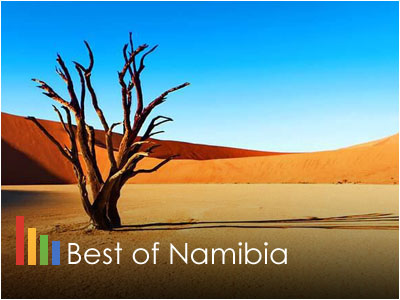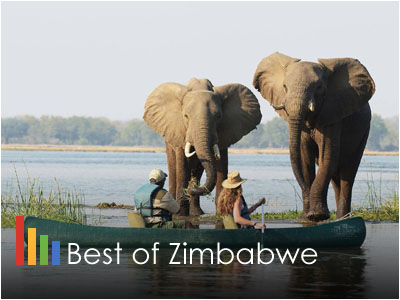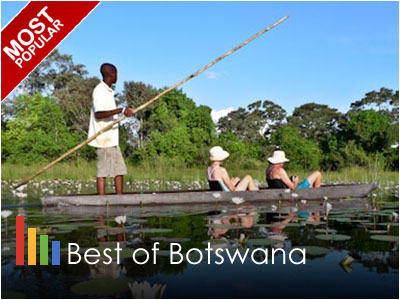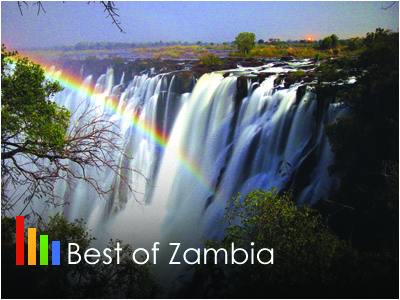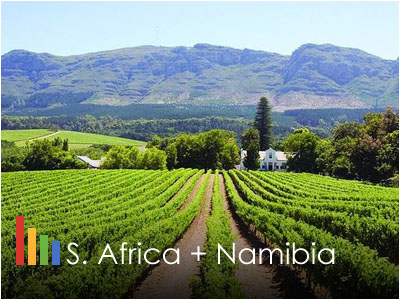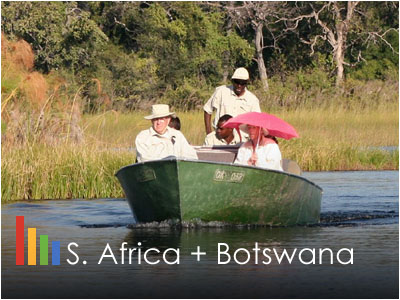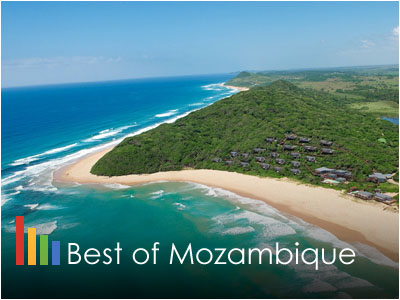Destination Namibia, Africa
Namibia - Namib Desert and more!
Namibia, a country in southwest Africa, is distinguished by the Namib Desert along its Atlantic Ocean coast. There simply is no frame of reference, nothing that comes close to seeing the sunset at Sossusvlei, spending the day playing at Swakopmund or visiting the Himba in Damaraland. People use all sorts of words to describe it: vast, endless, magnificent, unimaginable, among others. Good words as far as words go, but they don't really do Namibia's top attractions justice. However, the landscape is not Namibia's only defining natural asset - the country is home to diverse wildlife, including a significant cheetah population. In the north, Etosha National Park’s salt pan draws game including rhinos and giraffes. The capital, Windhoek, and coastal town Swakopmund contain German colonial-era buildings such as Windhoek's Christuskirche, built in 1907. Fish River Canyon Park is a scenic dream, and the majestic Epupa Falls are not to be missed. If your idea of a dream vacation includes plenty of outdoor adventure and nature photography, then Namibia is the ideal spot to explore.
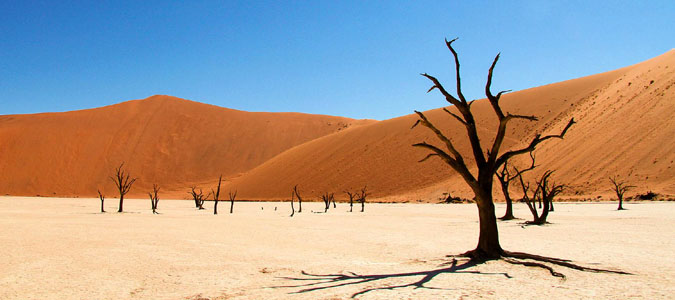
Namibia - Basic Facts
Namibia officially the Republic of Namibia, is a country in southern Africa. Its western border is the Atlantic Ocean; it shares land borders with Zambia and Angola to the north, Botswana to the east and South Africa to the south and east. Although it does not border Zimbabwe, less than 200 metres of the Zambezi River separates the two countries. Its capital and largest city is Windhoek. Namibia, the driest country in Sub-Saharan Africa, was inhabited since early times by the San, Damara and Nama people. Around the 14th century, immigrating Bantu peoples arrived as part of the Bantu expansion. Since then, the Bantu groups, the largest being the Aawambo, have dominated the population of the country; since the late 19th century, they have constituted a majority. Namibia has a population of 2.6 million people and a stable multi-party parliamentary democracy. Agriculture, herding, tourism and the mining industry – including mining for gem diamonds, uranium, gold, silver, and base metals – form the basis of its economy. The large, arid Namib Desert has resulted in Namibia being overall one of the least densely populated countries in the world.
About Namibia - from Namib Desert to Etosha Tribes
Tourism is a major contributor to Namibia's GDP, creating tens of thousands of jobs directly or indirectly and servicing over a million tourists per year. The country is a prime destination in Africa and is known for ecotourism, which features Namibia's extensive wildlife. There are many lodges and reserves to accommodate eco-tourists. Sport and trophy hunting is also a large and growing component of the Namibian economy, accounting for 14% of total tourism in the year 2000, or 19.6 million US dollars, with Namibia boasting numerous species sought after by international sport hunters. In addition, extreme sports such as sandboarding, skydiving and 4x4ing have become popular, and many cities have companies that provide tours. The most visited places include the capital city of Windhoek, Caprivi Strip, Fish River Canyon, Sossusvlei, the Skeleton Coast Park, Sesriem, Etosha Pan and the coastal towns of Swakopmund, Walvis Bay and Lüderitz. Windhoek plays a very important role in Namibia's tourism due to its central location and close proximity to Hosea Kutako International Airport. Here is a selection of Namibia’s Top 10 most popular and unmissable destination attractions;
Namibia's Famous Cities, Towns and Regions
Windhoek: The most common place to visit in Namibia is the capital and largest city of Windhoek. If you’re setting on a lengthy safari, there is a good chance that it will start in Windhoek. However, there are several reasons to stick around and enjoy some time in the city. If you’re interested in Namibian history, be sure to check out the Parliament of Namibia as well as the old Lutheran church called the Christuskirche. If you’re hoping to pick up some souvenirs, Windhoek is a great place to go shopping. Along with some of the smaller local markets, there are bigger shops located in the Maerua Mall..
Walvis Bay: Walvis Bay is a major port on the Namibian Coast. Owing to its tactical position on the Atlantic coast, with access to one of the finest deep water harbors this side of the Cape of Good Hope, Walvis Bay has been a plaything for the historic superpowers in the African theater of war. The Portuguese passed this way, then the Brits, then came the Germans in the First World War, each raising evermore elaborate dock structures and depots. Now, with the colonial conflicts long in the past, the city is one of the top tourist draws in all of Namibia. It’s got kitesurfing along its beaches, oodles of fishing opportunities, tour organizers touting excursions to the bird-rich islands out at sea, and sand boarding on the dunes of the Namib Desert. It is also a hugely popular destination for travelers and locals in search of desert sports. At the lagoon, you can try kitesurfing thanks to strong winds on the water. Head inland and you can try out dune boarding, a hotter take on snowboarding that makes the most of the sandy desert landscape. Back on the coast, you can go fishing or set off on a dolphin or seal-watching cruise. There are lots of opportunities for birdwatching, particularly at the wetlands where flamingos.
Swakopmund: If you want to see where local Namibians go on vacation, check out the coastal destination of Swakopmund. Originally a German colonial city, Swakopmund boasts a lot of colorful and historic architecture. It is known as the adventure capital of Namibia, and it is easy to see why. if you visit Swakopmund, you’ll have the chance to go quad biking in the desert, set off on camel safaris, try sandboarding on nearby dunes or just relax on the beach. There are also dozens of great international restaurants and several fantastic bars serving up locally brewed beer. Pretty as a picture, the scenic seaside town of Swakopmund breathes fresh salty air into the dry desert landscape. It is a popular stopover for visitors to Namibia and the quaint and pretty town offers plenty in terms of sights, places to eat and things to do.
Luderitz Town: As a former German colony, Namibia has a lot of german influences on its culture, language and cuisine. One of the most obvious places to notice this influence is in the coastal town of Luderitz. With Art Nouveau architecture and countless German street names, it is easy to feel like you’re in Bavaria rather than Namibia. On a visit to Luderitz, you can spot the Deutsche Afrika bank building, old Lutheran churches and the popular Troost House. Don’t miss a chance to see the nearby ghost town of Kolmanskop, which was once a hub for diamond mining. Sand dunes have now overtaken the town, making it both eerie and beautiful.
Kaokoland and the Himba Tribes: The harsh and unforgiving Kaokoland is recognised as one of the last true wilderness areas in southern Africa. There are few places in all of Africa like the carved lands of Kaokoland. Desert elephant and rhino tracking are popular activities in the region, which is also home to the Himba people who have survived in the desert for thousands of years. They mainly come to encounter the perennially-smiling Himba folk, who’ve scraped a living from the wilderness here as nomads for centuries. Kaokoland is also the home to the fascinating mountain elephant; specially adapted for life with little water.
Namib Desert and Naukluft National Park
The Namib Desert claims the title of the oldest in the world and dishes up panoramic landscapes that are second to none. It is an immense expanse of relentlessly moving gravel plains and dunes that stretch along the entire Namibian coastline and holds evidence of human existence dating back to the Stone Age. As the name suggests, the Namib-Naukluft National Park contains both the Namib Desert and the Naukluft Mountain Range. It’s also the largest game park in Africa and a beautiful setting. Much of the park is made up of red sand dunes, a shifting landscape that you have to see to believe. You’ll be able to see lunar-esque landscapes and spot some of the more remarkable high dunes in person. The most famous area of the park is Sossusvlei, Namibia’s most popular strip of sand, where gargantuan dunes tower more than 300 meters (1000 feet) above the ground. Sossusvlei is an iconic Namibian landmark and one of the most-visited locations in the country. Red dunes, eerie silence, still air and the enormity of the desert make this a genuinely one-of-a-kind destination. You should also check out the Kuiseb Canyon, through which the Kuiseb River runs when it is not just a sandy riverbed. The famous Dead Vlei is a clay pan characterised by dark, dead camel thorn trees that are believed to be over 900 years old, and stand in stark contrast against the white pan floor. Make sure to have you camera handy when visiting this exquisitely photographic site.
Etosha National Park
The second largest of Namibia’s game reserves after Namib-Naukluft, Etosha National Park surrounds the vast Etosha salt pan. The pan itself is usually dry and only fills with water briefly in the summer, but is enough to stimulate the growth of a blue-green algae which lures thousands of flamingos. Most of the wildlife, including herds of zebra, wildebeest and antelope, can be seen around the waterholes that border the pan. Etosha is served by five well established rest camps and offers a great self-drive safari experience. If you can only stop by one of Namibia’s national parks, make it this one. Yes sir, Etosha has been famed for its wealth of rare animal life for more than 100 years – it was first proclaimed a game reserve way back in 1907! Today, the region, which encompasses dry and cracked salt pans and the labyrinthine valleys of the Leopard Hills (stalked by their eponymous beast, of course), is the safari kingpin of the country. Come and spy out the African bush elephants and plains zebras at the watering holes, get a glimpse of the uber-rare black rhino, or witness the springing springbok. Etosha National Park. game viewing is almost always good around the watering holes, and the park can be visited the whole year through.
Skeleton Coast National Park
The Skeleton Coast got its name from how dangerous it was to sail a ship along the coast in centuries past. To this day, the desolate coastline is still known as the world’s biggest ship graveyard. The Skeleton Coast National Park is mostly uninhabited, with a few sparse villages dotting the landscape. Most visitors come specifically to see the Cape Cross Seal Reserve. The reserve is historically significant because it was the 15th century landing spot of the first European to visit the Namibian Coast. More importantly for most visitors, it is now a breeding colony for more than 200,000 cape fur seals. Namibia’s Skeleton Coast is a harsh and unyielding landscape where only the hardiest of desert-adapted animals survive. It is also notorious for its rough seas and thick fog that has claimed the lives of many sailors over the years. A coastline littered with shipwrecks attests to the treacherous conditions.
Fish River Canyon Park
At Fish River Canyon Park, you’ll be able to see one of the largest canyons in the world. Known in Afrikaans as the Visrivier Afgronde, the canyon is formed by the Fish River, one of the longest in Africa. There are several fantastic ways to view and experience Fish River Canyon Park in person. The Fish River Canyon winds and weaves between the great mountains of southern Africa in truly majestic fashion. Red-hued rocks tower atop the valley bottom, pits of deep sand and colossal boulders spot the landscape, and the sunsets glow blood-red against the rugged ranges known as the Three Sisters. For intrepid travelers, the hiking path that runs the length of this great wonder can hardly be resisted. It crosses high passes and arduous tracts of dusty lands, covering a mega 88 kilometers from start to finish.If you’re up for a hike, the Fish River Canyon Trail is very popular. Keep in mind that the full length of the trail is more than 80 km (50 miles). You can also take a scenic flight over the top of the canyon or even go for a swim right in the Fish River. This magnificent canyon is the largest in Africa and one of Namibia’s most frequently visited attractions. Its enormous ravine houses the longest interior river in the country, and hot springs can be found near its lower reaches.
Waterberg Plateau Park
Located in Northern Namibia, the Waterberg Plateau Park is a large sandstone plateau of red rock that serves as a sanctuary for endangered animals. Most visitors come for a guided tour that allow you to spot buffalo, rhinoceroses and antelope. The park is also home to more than 200 species of birds, and it is a breeding ground for Cape vultures. A few adventurous travelers each week can set off on extensive hikes through the Waterberg Plateau Park. This is only allowed between April and November, and all hikers need to have the appropriate permits and guides. There lodges and campsites just outside of the park providing amenities and accommodation to travelers.
Cape Fur Seals of the Cape Cross - Hentiesbaai
The name refers to the large stone cross erected here by Portuguese explorers in the 15th century. Situated 120km north of Swakopmund, Cape Cross is home to one of the largest colonies of Cape Fur Seals in the world. The surrounding area was proclaimed a reserve in 1968 to protect the biggest and best known of the 23 colonies of Cape Fur Seals which breed along the coast of South Africa and Namibia. During the November / December breeding season as many as 150,000 seals gather at Cape Cross. The gateway to the National West Coast Recreation Area is one of Namibia’s most popular high-season tourist draws for domestic travelers. Oodles of folk leave behind the city streets of Windhoek and head to the wind-blasted shoreline here. They come to ride rumbling 4X4s over the undulating desert dunes, to break out into the inhospitable wildernesses of the Skeleton Coast, and to see the thousands of seals that pepper the beach banks to the north of town. The town is also known for its diversity of marine life, which draws anglers and boaters to boot.
Penguin Islands
Following neatly on from Walvis Bay, this smattering of rocks and tiny islets that poke above the Atlantic close to the spot of coast where the erstwhile German harbor town can be found is another top draw for travelers in the region. As the name suggests, they are occasionally dotted with colonies of the African Penguins (Spheniscus demersus). The African penguin is only found on the south-western coast of Africa, living in colonies on 24 islands between Namibia and Algoa Bay, near Port Elizabeth, Namibia. It is the only penguin species that breeds in Africa and its presence gave name to the Penguin Islands. However, those flat-footed waddlers aren’t the only draw. There are breathtaking headlands and cliffs to see, along with a whole host of other unusual avian and sea life.
Caprivi Strip
Caprivi, or more appropriately the Caprivi Strip, is a long, thin needle of land that pokes its way into the heart of west southern Africa from the northern reaches of Namibia. Unlike the rest of Namibia, the Caprivi Strip is blessed with lush vegetation and abundant water. The Caprivi Strip is a narrow strip of land between Botswana on the south, Angola and Zambia to the north, and Namibia’s Okavango Region to the west. The Caprivi is the wettest region in Namibia with its high rainfall and a number of major rivers like the Okavango, Kwando and Zambezi. The abundance of water sustains a large variety of animals, including a large population of elephants. The wildlife is being protected in four reserves. There are no fences however, so the animals can roam freely across the borders of the neighboring countries. There are five protected areas within the Caprivi where big game can be found. The Popa Falls are popular for day trips and it’s a great area to do some bird spotting.
Epupa Falls
On the border between Namibia and Angola, in the region known as Kaokoland, you’ll find Epupa Falls. These waterfalls are created by the Kunene River, and they are spread out over a mile. Surrounding the falls are colored rock formations, palm trees and fig trees. Although Epupa Falls is remote and only accessible by 4×4 vehicles, it remains a popular attraction in Namibia. Most travelers who visit Epupa Falls opt to stay overnight in one of the surrounding lodges. If you want to add some adrenaline to your day, you can also try out some whitewater rafting along the river. For more information regarding Namibia Holiday Travel ideas, DO NOT hesitate to Contact Us.
AfriChoice operates a wide range of carefully designed tours and safaris to Namibia by providing transport and booking a hotel for you. Our safari consultants will always be at your assistance should you need a tailor-made holiday to this unique destination. NB: For more information regarding Namibia Travel, DO NOT hesitate to Contact Us.
Contact Us for more information:
Our Top Southern Africa Trips
-
Best of South Africa
South Africa's Best Spots
-
Best of Namibia Safari
Explore Namib Desert & More!
-
Best of Zimbabwe Safari
Explore Mana Pools and Beyond
-
Best of Botswana Safari
Discover Okavango Delta & Beyond
-
Best of Zambia Safari
Discover Zambia's Secrets
-
S. Africa & Namibia
From Winelands to Namib Desert
-
South Africa & Botswana
From Kruger to Okavango Delta
-
Mozambique Private Locations
Mozambique's Hidden Spots
Other POPULAR Safari Destinations! Explore Our Safari Destinations - EAST AFRICA and BEYOND!
-
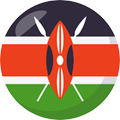
Kenya
KENYA - Traditionally known as the true home of African Safari & Beach Holidays. -

Tanzania
TANZANIA - The land of Kilimanjaro, Serengeti National Park and Zanzibar Islands. -

Uganda
UGANDA - Popular for the Gorilla Tracking Adventures and the source of River Nile. -
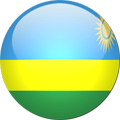
Rwanda
RWANDA - Emerging safari destination also know for it Mountain Gorillas and more. 
Indian Ocean
AFRICAN BEACHES - Know for its Turquise Blue waters and the pristine sandy beaches.-

Others
OTHER DESTINATIONS - We also offer trips to holidays to other African countries of interest.



 Paul Kitching - UK
Paul Kitching - UK Karen Howard - CANADA
Karen Howard - CANADA